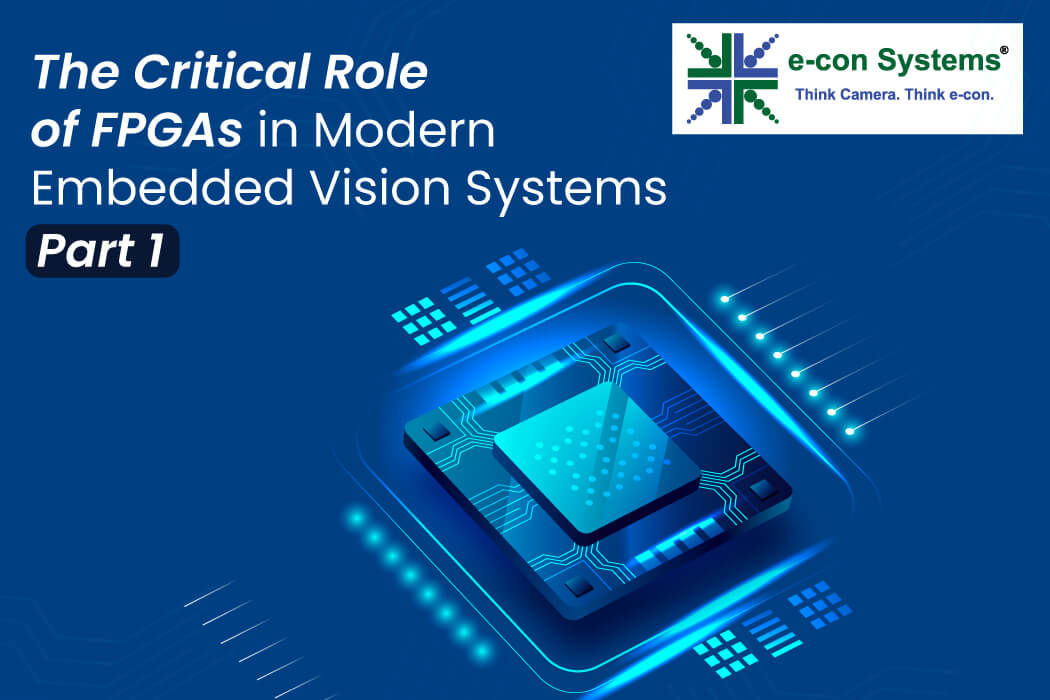As the adoption of embedded vision keeps taking quantum leaps across industries, the market for high-performing and energy-efficient systems has become extremely prominent. Fortunately, FPGAs have grown as a feasible solution for meeting the unique prerequisites of these systems.
In this two-part blog series, you’ll get expert insights into the relevance of FPGAs in embedded vision – and why the time is now for you to take notice. In part 1, learn about what FPGAs are, the current limitations that demand this breakthrough technology, and how it delivers unmatched advantages for interface ports in embedded vision applications.
FPGAs in a nutshell
Field Programmable Gate Arrays (FPGAs) can be defined as integrated circuits that can be configured post-manufacturing to execute distinct tasks. Unlike conventional processors based on fixed architectures, FPGAs comprise programmable logic blocks that are interconnected through customizable routing. So, developers can design specialized hardware functions to accomplish tasks like image processing or signal analysis. FPGAs excel in parallel processing, making them perfect for compute-intensive workloads where high-speed data handling is necessary.
Challenges in Embedded Vision Driving the Need for FPGAs
Shortage of interface ports
Traditional processors face a bottleneck regarding how many interface ports they can offer. It forms a gap between the system’s input or output needs and its power to support concurrent operations. The inability to expand port availability also inhibits scalability and limits integration with extra components.
Limited interface requirements
Beyond the sheer number of ports, embedded vision systems demand compatibility with a variety of interface types, such as MIPI, USB, GigE, or HDMI. Standard processors are constrained in supporting multiple interface standards, which causes design complexities and rising costs.
Latency in CPU-only systems
Central processing units (CPUs), while highly capable for general-purpose computing, are not optimized for low-latency, high-throughput operations. As a result, relying solely on CPUs introduces delays in processing, which can be detrimental in time-sensitive tasks.
Processing power vs. energy consumption
Achieving the right processing capacity while maintaining a low energy footprint is critical. Traditional architectures fail to meet this dual requirement, either consuming excessive energy or sacrificing processing capability.
Lack of design portability and flexibility
Many embedded vision systems lack the hardware architecture to transition between applications or scale to support new use cases. Modifying designs for portability involves a lot of rework, which increases development time.
Ineffective sensor integration
Integrating advanced sensors into existing systems without major hardware modifications often requires comprehensive updates to accommodate newer sensors. This ends up delaying deployment while adding to costs.
How FPGAs Make Interface Ports More Developer-Friendly
Aggregator for interface ports
Applications like autonomous systems, smart surveillance, and industrial robotics need connections to numerous sensors, far exceeding the number of ports available on most processors. FPGAs address this by acting as aggregators for multiple cameras. With support for an array of interfaces like MIPI, PCIe, Ethernet, SubLVDS, SLVS-EC, and LVDS, FPGAs ensure seamless connectivity between cameras and processors.
Developers can consolidate data streams from multiple cameras into a unified format, which simplifies hardware design and optimizes system performance by reducing the load on the main processor.
Bridging for interface ports
In many embedded vision applications, the processor may lack compatibility with certain interface standards required by sensors or displays. For example, higher frame resolutions may exceed the bandwidth capacity of existing interfaces, or a processor may lack the required type of port altogether. FPGAs are the perfect bridging solution for effectively connecting incompatible components within the system.
FPGAs equipped with memory buffers or FIFO (First In, First Out) mechanisms provide a cushion to resolve bandwidth conflicts between sensors and processors. It enables the smooth transmission of high-resolution data, even in systems with bandwidth constraints. FPGAs offer full-stack solutions for multiple interfaces to accelerate development timelines and minimize design complexity. They also have the ability to address specialized screen refresh requirements.
Mirroring for interface ports
Embedded vision systems require output to multiple displays, but most processors come with a limited number of display ports. FPGAs provide mirroring functionality, enabling systems to connect to more displays without modifying the host hardware. FPGAs can also upscale or downscale video streams so that the output can match the requirements of different displays.
Their mirroring capability can be invaluable in applications where simultaneous output to multiple displays is important.
Stay tuned for part 2 in which you’ll learn about FPGAs help tackle vision algorithm challenges!
Maximize the Power of FPGAs with e-con Systems
e-con Systems has been designing, developing, and manufacturing OEM camera solutions
since 2003. Thanks to our partnership with leading FPGA vendors like Lattice, Xilinx and so on, we can simplify the development of customized FPGAs-powered camera solutions to meet application needs in industries like medical, ADAS, industrial, and more.
They include:
- See3CAM_CU83 – 4K AR0830 RGB-IR USB 3.2 Gen 1 Camera
- DepthVista_USB_RGBIRD – 3D Time of Flight (ToF) USB Camera
- See3CAM_CU135M – 4K Monochrome USB 3.1 Gen 1 Camera
- See3CAM_CU30 – Low Light USB Camera
Our solutions leverage Lattice Semiconductor’s FPGA chips, including Crosslink, Crosslink NX, ECP5, and Certus-NX, to deliver exceptional performance.
Furthermore, e-con Systems’ expertise gives you access to custom design services, reference designs and demos software tools, IP cores, and hardware platforms.
Use our Camera Selector to check out our complete portfolio.
If you need help integrating custom cameras into your embedded vision applications, please write to camerasolutions@e-consystems.com.

Prabu is the Chief Technology Officer and Head of Camera Products at e-con Systems, and comes with a rich experience of more than 15 years in the embedded vision space. He brings to the table a deep knowledge in USB cameras, embedded vision cameras, vision algorithms and FPGAs. He has built 50+ camera solutions spanning various domains such as medical, industrial, agriculture, retail, biometrics, and more. He also comes with expertise in device driver development and BSP development. Currently, Prabu’s focus is to build smart camera solutions that power new age AI based applications.




